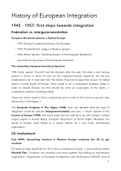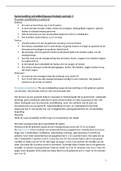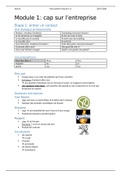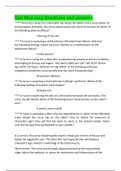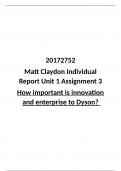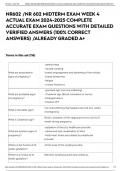History of European Integration
1945 - 1957: first steps towards integration
Federalism vs. intergovernmentalism
European Movement plea for a Federal Europe
- 1923: Richard Coudenhove-Kalergi: Pan-Europea
- 1929: Aristide Briand: League of Nations speech
- 1944: Altiero Spinelli: “Draft Declaration of the European Resistance”
- Jean Monnet: key player of the European federalists
The competing intergovernmental perspective:
1946 Zurich speech Churchill (lost the elections after the war). He made a very famous
speech in Zurich in which he laid out the intergovernmental argument. He was pro
collaboration, but it must start from the states. They had to keep their power. He talked
about a United States of Europe. There needs to be a cooperation between states in
order to rebuild Europe, but this should be done on sovereignty of the states ->
cooperation based on sovereign states
These two visions need to find a compromise and in order to find common ground, they
discuss this in the Hague ->
The European Congress in The Hague (1948): here was decided what the type of
integration would be and the intergovernmentalist view wins -> result: creation of the
Council of Europe (1948): still exists today but has nothing to do with Europe. Limited
output, expect in Human Rights: European Declaration of Human Rights. Members: the
whole of Europe, even Russia to a certain extent. It’s a very loose international
organization.
US involvement
Post WWII: devastating situation in Western Europe motivates the US to get
involved.
US wants to help: beneficial for US to have a prosperous Europe -> good selling market:
Marshall Plan. Condition: the countries must work together by building an international
organization: Organization of European Cooperation and Development (OECD): kind of
1
,pushed the European states to work together very closely and made the reconsutruction
of Germany possible. Greece (1947), NATO (1949).
The Marshall Plan opens the issue of German rehabilitation: how to reconcile the recovery
of the German economy with the economic development and military security of France?
France and Jean Monnet
France reluctantly sees the uncontrolled economic recovery of Germany. They know
Germany needs to be part of the reconstruction, but they don’t want them to become too
big/ dominate and lose control.
Jean Monnet (top civil servant) persuades Robert Schuman (minister of foreign affairs) to
radically change the French position towards becoming a supporter of the creation of a
supranational organization to manage the economic sectors of coal and steel
(importance in war). Jean Monnet lays the focus on how important it is for France to
reconstruct Germany.
Jean Monnet proposes the first step of the supranational European integration and the
spill over concept. The integration of the coal and steel sectors would lead to the
integration of the whole economy.
Schuman’s proposal is supported by Adenauer (BRC) en Acheson/Truman (US)
The Schuman Declaration and the ECSC
Schuman-Declaration (9 May 1950): proposal to establish a supranational organization
among France and Germany and an invitation to the Benelux and Italy to join the
initiative.
The UK was not invited, because France feared that a British rejection of the
supranational nature would endanger the integration process.
April 1951: signing of the Treaty of Paris establishing the European Coal and Steel
Community (ECSC). Coal & steel were the essential sectors to rebuild Europe and the
sectors needed to buil a military defense
Augustus 1952: foundation of the ECSC as a supranational organization
Structure and policy of the ECSC:
- Creation of a High Authority (European Commission), a Court of Justice, a Council
of Ministers and a Common Assembly (European Parliament) -> the 4 out of 5 main
institutions were established here, but in another way as they exist now
2
, - Creation of a common market for coal and steel and common control over
production, price-setting and competition
Failed attempt to establish a European Defense Community
Pleven-plan (1950): a European Defense Community (EDC) aiming to remilitarize West-
Germany under control of other West European states
Negotiations between the 6 member states of the ECSC (1951-1952)
May 1952: signing of the EDC Treaty
Why was it so important to have a united defense? Because of the Cold War and the
Korean War (Americans were going east so Europe lost its defense)
Failed rati cation of the EDC Treaty in the French Assemblée (1954), under pressure of
Charles De Gaulle: he wanted it in an intergovernmental way. He never accepted the idea
of a common defense.
Alternative and successful attempt to remilitarize: West-Germany (BRD) becomes NATO-
member in 1955.
The idea of spill over was taken in a too ambitious and not realistic way: To jump from a
corporation in coal and steel into a political and military corporation on a high level. So,
Monnet said there were many more steps needed. Nevertheless, the next step taken was
a military step. Why? Because of the Cold War, the SU and the Korean war. So, the idea
was: we already have coal and steel and now we need European defense. In the end it
fails, it also fails in France. Because De Gaulle comes at ‘power’ in France, and he had an
intergovernmentalist preference, he never accepted European defense community.
However, the idea of defense was still there, and this resulted into the NATO. And until
today, European defense is one of the areas where corporation is very low profile
Foundation of the EEC and EURATOM
Monnet’s spill-over logic adds a new sector to the integration: atomic energy
Messina 1955: ECSC Foreign Affairs Ministers commission a report of Paul Henri Spaak
discussing further steps in the integration process
Venice 1956: ‘Report Spaak’ proposes to establish two new organisations: (one for
atomic energy and one for a common market): start of an Intergovernmental Conference
(IGC)
3
fi
, All ECSC member states support the idea, although France initially rejects the common
market idea (reasons: overseas territories, agriculture, national industries)
Even though defense was off the table, the idea of spill over remained very active. The
idea was that it should be expended to other (economic) sectors + the idea to add other
energy sources to coal (such as nuclear). Spaak starts discussing next steps, which resulted
in the idea that two new organizations need to be established.
Negotiations among the 6 ECSC member states lead to The Treaties of Rome (1957)
- the EURATOM-Treaty
- the Treaty establishing the European Economic Community (EEC)
- Rati cation of both treaties in 1957
New institutions effective in 1958
- The High Authority becomes the European Commission
- More competencies for the Council of Ministers
- The Common Assembly and the Court of Justice remain unchanged
- Brussels becomes the ‘Capital of Europe’
1958 - 1969: De Gaulle dominates European
politics
De Gaulle’s European policy
1958: start of France’s ‘Fifth Republic’, Charles De Gaulle becomes president of France.
He was a nationalist. His goal was clearly in favor of economic integration, because he
was convinced it would be beneficial for France. European integration as a tool to support
and realize French economic prosperity
- devaluation and economic reform prepare France for the European customs union,
thus making the customs union possible
- plea for a Common Agriculture Policy (CAP) to support and co-finance the reform of
the French agriculture sector. Agriculture in Europe can only survive thanks to
subsidies
Goal: to pursue France national interest: economic integration as a tool to support the
French goals. It was a mixed interest: De Gaulle wanted to add agriculture since it’s a
crucial sector for France. Agriculture can only survive when it’s heavily subsidized (cannot
compete with countries as China). The more a country depends on agriculture, the more
expensive it is to stay an important country.
4
fi
,In the meantime, the UK is outside of the European Integration. It’s not part of the
founder states. But in the UK, people start to realize that European collaboration is not
that bad. They noticed that the states are growing (economically). The UK seeks a similar,
but less deeply integrated, cooperation form with other states, to benefit from economic
advantages but don’t give up their power. Result: European Free Trade Association
(EFTA) in 1960. Members: UK, Austria, Denmark, Norway, Portugal, Sweden, Finland. This
still exists today, but all the member states became member of the European Union.
Intergovernmental way of organizing. It’s purely trade.
Strengthening of the German – French Axis, based upon the excellent personal
relationship between Konrad Adenauer and Charles De Gaulle. French-German
Friendship Treaty (‘Elysée-Treaty’, 1963)
De Gaulle aims to incorporate supranational economic integration in a broader
intergovernmental political and military cooperation. Ultimate aim: to establish a
‘European Europe’, starring France as the undisputed political leader
Fouchet-plan (1960 - 1962): proposal to establish intergovernmental cooperation in the
field of foreign and defense policies. Other countries think the goal of France will make
France too powerful
- German support: German – French axis, opportunity for rehabilitation
- Rejected by the other EEC member states: too intergovernmental
Evolution of the EEC
(Not super important)
Elaboration of the EEC institutional structure:
- European Commission: Hallstein becomes first president, development of the
administration
- Council of Ministers: secretariat based in Brussels, establishment of the COREPER
- Court of Justice: start of influential case-law
- Common Assembly: first plenary meetings
Development of the EEC’s policy content:
- Customs Union: abolishment of internal tariffs, common external tariff
- External Policies: GATT-negotiations, Yaoundé-convention
- Competition, Transport, Energy, Social Affairs: very slow progress
- CAP: progress thanks to a common understanding between the European
Commission and Charles De Gaulle
5
,The European community evolves step by step. The speculations of the treaty are being
put in practice. We have to create these institutions and they will make policy.
The “Empty Chair” crisis
Dispute between the European Commission and France with respect to the financing of
the Common Agriculture Policy:
The proposals of the European Commission:
- ‘Own resources’ for the EEC: this would mean direct income (<-> contribution) ->
European tax and import duties.
- More powers for the European Commission and the Common Assembly at the
expense of the member states
- Majority Voting to replace unanimity: countries can no longer veto a proposal,
which means you have to accept, as a losing country, they way the other countries
want to go
De Gaulle pushes for agriculture, while the EC pushes for supranational integration ->
these two ideas clash
These proposals are unacceptable for France: too much loss of sovereignty. Result: France
leaves the negotiations and refuses to participate in the meetings of the Council of
Ministers: the ‘empty chair’ crisis (1965). No decisions can be made, because at that
time, there was still unanimity. This blocks the European integration completely. This also
means no decisions about CAP (Agriculture) can be made, so France puts itself in a wrong
position.
Other member states refuse to give in
France eventually shows up again (1966) and accepts a compromise:
- interim financing of the CAP
- postponement of the ‘own resources’ issue
- the ‘Luxembourg Compromise’ (‘agreement to disagree’): voting by qualified
majority becomes possible. However, whenever a state is of the opinion that the
matter at hand is at vital interest for that state, even if we decided that we should
vote by majority, that state can decide to go back to unanimity. Majority however
makes decision making go faster.
Result: EEC can get back to work, but intergovernmentalism is reinforced
- The intergovernmental method becomes even more crucial
6
, - Decision-making procedures are slowed down
The Luxembourg Compromise
1. ‘When issues very important to one or more member countries are at stake, the
members of the Council will try, within a reasonable time, to reach solutions which can
be adopted by all members of the Council, while respecting their mutual interests,
and those of the Community.’
2. ‘The French delegation considers that, when very important issues are at stake,
discussions must be continued until unanimous agreement is reached.’
3. The six delegations note that there is a divergence of views on what should be done
in the event of a failure to reach complete agreement.’
4. However, they consider that this divergence does not prevent the Community’s work
being resumed in accordance with the normal procedure.’
(Just read closely)
The UK’s membership application
The UK applies a first time for EEC membership in 1961
- Commonwealth and EFTA show worse economic figures than EEC
- UK is deeply divided with respect to EC membership
- Prime Minister Macmillan was an Atlanticist and received President Kennedy’s
support for EC membership application
Very difficult negotiations
- De Gaulle distrusted the UK-US ties
- Discussions with respect to agriculture, Commonwealth and EFTA
- Nassau-agreement between UK and US: US missiles in the UK
De Gaulle vetoes British membership in 1963
At that point in time, the UK is outside the EEC, but it sees that this economic integration
produces more growth and wealth than the EFTA. Therefore, the UK wants to defect the
EFTA and become part of the EEC, even though they don’t like the final aim of the EEC
-> they want to change it from within and make it less supranational.
Everyone in the EEC needs to accept this application, but France isn’t eager to, because
De Gaulle is afraid that the UK will become more powerful than France
7
,The UK applies a second time for EC membership in 1967
- EFTA is still performing economically worse than the EC
- Still deep divisions within the UK with respect to EC membership
De Gaulle reacts much faster and declares that the UK is politically and economically not
ready for EC membership -> second veto of France
May ’68 revolt forces De Gaulle to resign in 1969 -> disappearance of De Gaulle is very
important for EI
The EEC slowly recovers from years of stagnation
- Fusion Treaty (1965): EEC plus ECSC = European Community (EC) (just a name
change)
- Successful negotiations of the GATT’s Kennedy-round
1969 - 1979: from Euro-optimism to Euro-
pessimism
New “relance” in The Hague
German Prime Minister Willy Brandt makes Germany more politically assertive
(‘Ostpolitik’). Germany starts performing very well economically. Brandt supports British
EC accession.
President Pompidou balances between the inheritance of De Gaulle and the aim to give
France a more central position in the European debate. France starts performing less well
economically. Pompidou becomes a supporter of British EC accession to ensure an
antidote for German economic hegemony.
Brandt and Pompidou were not part of similar parties, but they did have the same ideas
about European integration. They come together at The Summit of The Hague (1969) ->
brings optimism
- Completion of the Common Agriculture Policy (CAP) (financing)
- Foreign Policy Cooperation (Davignon)
- Monetary Policy Cooperation (Werner)
- British accession negotiations as from 1970
8
,Results of The Hague
Own resources for the EC: all import tariffs and maximum 1% of VAT (BTW) revenues
does directly into the EC -> rich states pay more
! no consideration of the net payer status of future member UK !
European Parliament receives limited powers over the budget
Report Davignon (1970): European Political Cooperation (EPC), outside the existing EC
institutional structure
- Davignon says we have to talk about common foreign policies
- At that point of time, the traits do not allow such talking, since they are only focused
on economic integration -> new track on EI -> align foreign policies about cold war,
middle east,… -> not much output, but still important that this was already talked
about
Report Werner (1970): ambitious plan to establish an Economic and Monetary Union
(EMU) within 10 years. Eventually, it took 30 years
Take-off of new accession negotiations
First enlargement
UK: applied twice, France vetoed twice, third application:
- Heath applies for EC membership in 1970
- Still deeply divided political elites within the UK
- Negotiations (1970-1971): mainly discuss agricultural and financial issues
- French referendum accepts UK accession in 1972
- UK ratification of the accession treaty in 1972
Norway: referendum rejects accession (53.5% against): agriculture, fisheries, oil
Denmark: referendum accepts accession (63% in favour), but much scepticism
Ireland: referendum accepts accession (83% in favour), start of a success story
UK, Ireland and Denmark become EC member states in 1973
9
, Economic and political crisis
End of the Bretton Woods agreements (1971) brings Europe in a recession and
increases the necessity for European monetary coordination: creation of the currency
‘snake’ (1972) and a call for an EMU (1972)
Oil crisis (1973) worsens the economic crisis, making forecasts to establish a common
monetary and energy policy very gloomy
EC – US tension: oil crisis and Israeli - Arab conflict
French – German tensions: Ostpolitik
British – German tensions: European Fund for Regional Development (EFRD)
Pompidou, Heath, Brandt disappear, Giscard d’Estaing, Schmidt and Wilson rise to
power
-> early 70s: stagnation
British re-negotiations
Prime Minister Wilson (Labour) wants to renegotiate the conditions of British membership
Giscard opposes, Schmidt supports the demand
The UK seeks to renegotiate more issues (CAP, Commonwealth relations)
Paris Summit (1974)
- Agreement with respect to the EFRD
- European Commission is asked to investigate a UK correction mechanism
Dublin Summit (1975): agreement with respect to the mechanism
UK Referendum accepts the Dublin compromise
Political consequence: the UK becomes an ‘awkward’ partner: UK will never be an
enthusiastic partner. Reason: money, especially when it comes to the contributions
UK understands the needs of France (agriculture), but turns the tables by saying they also
have needs (coal, steel, industry) -> second budget line (ERFD) needs to go to industry:
UK renegotiates and wins
French - German axis
Excellent personal relationship between Schmidt en Giscard d’Estaing
10

